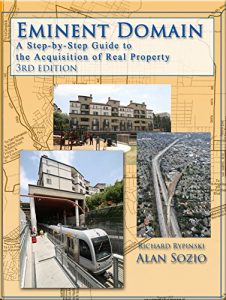The new, completely updated edition of Eminent Domain: A Step-by-Step Guide to the Acquisition of Real Property is a thorough and precise step-by-step guide through the process California public agencies are required to follow in order to acquire private property for public purposes, from project inception and land valuation through filing and obtaining possession.
For public sector attorneys, land acquisition staff and appraisers, and others who need to know how the eminent domain process works.
This 2015 edition includes significant updates regarding procedural changes and court rulings occurring in the eminent domain law since the last edition, as well as updated recommendations and practice suggestions and the latest legal references and statutory and procedural requirements. Of particular significance are the change in regard to obtaining an order for prejudgment possession, the author's discussion of accurately describing property interests to be acquired and defining public use, leaseback obligations, the agency's obligation to offer to pay costs of an owner appraisal, and recent case law regarding the court's interpretation of the California Environmental Quality Act (CEQA) and its relation to the ability to maintain an eminent domain action.
The following topics are covered:
An overview of California's eminent domain law
The most common legal rules associated with the valuation of real property, private property condemnations, right to take, and just compensation
Assembling the required documents, maps, and legal descriptions, including project plans and environmental documents
Appraisals and the selection of an appraiser
Complying with CEQA, the California Environmental Quality Act
Machinery and equipment, and issues of goodwill valuation and relocation assistance
Preparing and making an offer to acquire property
Preparing and adopting a resolution of necessity supported by an adequate administrative record
Preparing eminent domain pleadings, the complaint, and the order of possession
How to avoid pitfalls that could make the acquisition process unnecessarily costly
Various recommendations for the successful acquisition of real property for public projects
About the Authors
Alan Sozio is a partner and a member of the Public Law Practice Group at Burke, Williams & Sorensen, LLP in Los Angeles, where he primarily focuses on public agency property acquisitions, including eminent domain and inverse condemnation litigation. Alan's property acquisition practice includes assisting public agencies with property acquisitions, from the preliminary stages all the way through condemnation trials and appellate work. In this capacity, he has served as acquisition counsel for the Alameda Corridor-East Construction Authority involving partial and full acquisitions for numerous roadway grade separation projects throughout the San Gabriel Valley. Alan also represents cities, redevelopment agencies, school districts, special districts throughout California on a wide variety of public acquisitions, and is a frequent speaker and publisher on issues related to the acquisition of property by public agencies. Alan graduated with honors from the McGeorge School of Law at the University of the Pacific, where he was an associate editor of the Transnational Lawyer and received American Jurisprudence Awards in Property, Evidence, and Legal Writing.
Richard Rypinski, author of the first two editions of Eminent Domain, is now retired from the practice of law, after a long career in both public and private practice.
For public sector attorneys, land acquisition staff and appraisers, and others who need to know how the eminent domain process works.
This 2015 edition includes significant updates regarding procedural changes and court rulings occurring in the eminent domain law since the last edition, as well as updated recommendations and practice suggestions and the latest legal references and statutory and procedural requirements. Of particular significance are the change in regard to obtaining an order for prejudgment possession, the author's discussion of accurately describing property interests to be acquired and defining public use, leaseback obligations, the agency's obligation to offer to pay costs of an owner appraisal, and recent case law regarding the court's interpretation of the California Environmental Quality Act (CEQA) and its relation to the ability to maintain an eminent domain action.
The following topics are covered:
An overview of California's eminent domain law
The most common legal rules associated with the valuation of real property, private property condemnations, right to take, and just compensation
Assembling the required documents, maps, and legal descriptions, including project plans and environmental documents
Appraisals and the selection of an appraiser
Complying with CEQA, the California Environmental Quality Act
Machinery and equipment, and issues of goodwill valuation and relocation assistance
Preparing and making an offer to acquire property
Preparing and adopting a resolution of necessity supported by an adequate administrative record
Preparing eminent domain pleadings, the complaint, and the order of possession
How to avoid pitfalls that could make the acquisition process unnecessarily costly
Various recommendations for the successful acquisition of real property for public projects
About the Authors
Alan Sozio is a partner and a member of the Public Law Practice Group at Burke, Williams & Sorensen, LLP in Los Angeles, where he primarily focuses on public agency property acquisitions, including eminent domain and inverse condemnation litigation. Alan's property acquisition practice includes assisting public agencies with property acquisitions, from the preliminary stages all the way through condemnation trials and appellate work. In this capacity, he has served as acquisition counsel for the Alameda Corridor-East Construction Authority involving partial and full acquisitions for numerous roadway grade separation projects throughout the San Gabriel Valley. Alan also represents cities, redevelopment agencies, school districts, special districts throughout California on a wide variety of public acquisitions, and is a frequent speaker and publisher on issues related to the acquisition of property by public agencies. Alan graduated with honors from the McGeorge School of Law at the University of the Pacific, where he was an associate editor of the Transnational Lawyer and received American Jurisprudence Awards in Property, Evidence, and Legal Writing.
Richard Rypinski, author of the first two editions of Eminent Domain, is now retired from the practice of law, after a long career in both public and private practice.












